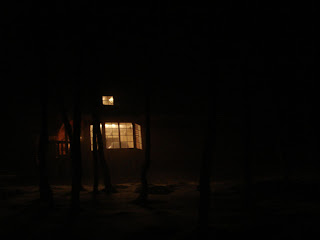Last weekend we drove South to an area called Nordland, where
one of Norway's most famous writers, Knut Hamsun, grew up. Since 2009 there has
been a Hamsun Centre in his home town of Hamarøy. I remember reading about it
at the time it opened: this architecturally unique tribute to a writer, lying
in a small village in the far North, where even most Norwegians never travel. I've
wanted to go there ever since.
I seem to remember reading that the architect
wanted the experience of moving through the five floors of the building to echo that of reading the writer's
prose in some way. The structure is an asymmetric box with a staircase climbing
through it at strange angles to platforms which are partly open. There is a
small library, and each of the other floors is a multimedia installation dedicated
to a different theme in Hamsun’s life and work, so you piece together some kind
of picture through a series of fragments.

Nature was profoundly important to Hamsun and one thing that
definitely works in the centre's favour is the the way the outside landscape is
incorporated into the experience of walking through the building. There is a roof
terrace which gives a kind of overview of the region, though a clear view is
deliberately obscured by a perimeter wall of tall cane. Then on each floor
there are carefully placed windows and different types of terrace from which
you get a "framed" view of an aspect of Hamarøy.
Because the doors to these outside areas are open, cold
gusts of air blow through the rooms in certain places. This slight element of
discomfort sits quite well with Hamsun's history.
Until a few years ago Hamsun was relatively obscure outside
Norway but he influenced a lot of 20th Century novelists. His first book,
Hunger, foreshadows much of what Beckett and Auster would write and, published
in 1890, is considered by some to be one of the first Modern novels. He would
be a national hero, were it not for the fact that he collaborated with the
German occupation. Although, unlike some other writers around this time (I'm thinking of Celine
and Pound, maybe Eliot too), he claimed never to have been anti-Semitic, he
was very pro Nazi. He went so far as to encourage Norwegian soldiers to desert.
Even when the writing was quite clearly on the wall for the German war effort, Hamsun wrote and published a
glowing eulogy for Hitler. The top floor of the centre is dedicated to a
discussion of how one might reconcile Hamsun's work with his political affiliations. Projected onto two walls is a fascinating film featuring a series of Norwegian intellectuals taking a
range of positions on both Hamsun's literary worth and his legacy.
What's most interesting to me about Hamsun's collaboration
is how he got there, especially given that his early books were initially
classed by the Nazis as degenerative literature. In the 19th Century he was in
many ways radically left wing. Yet Hamsun didn't exactly become a collaborator
through the proverbial reactionary drift. Like many European artists and
radicals of the 19th Century, he detested Britain and its Empire. He looked instead to Germany as a
country in touch with the traditions of the soil and as the home of the
Peasant's Rebellion. Germany was the great European alternative.
By the time of the Second World War Hamsun was an old man,
but he held on fiercely to the ideas of his youth. For him, his enemy's enemy
would always be his friend. The rise of Germany had been his life long dream.


















